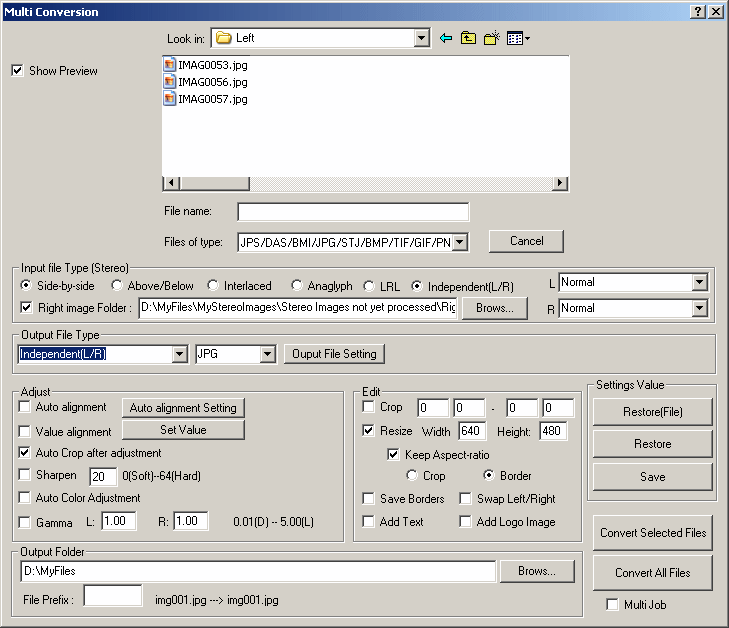
'Multi Conversion' allows the user to select some or all image-files (of the same stereo format) in a folder and batch-convert them to another format, compressed or uncompressed, resized, with altered contrast (gamma 0.01 to 5.00), rotated, repositioned horizontally and/or vertically, left/right swapped and sharpened or softened.
Using the very powerful auto-alignment feature, hundreds of images may have their errors corrected and be mounted relative to the stereo 'window', saving hours of manual work.
For auto-correction, maximum image width and/or height should not exceed 16,383 pixels.
'Multi Conversion'is also useful for batch-resizing non-stereo images, simply call the input/output file types 'side-by-side' .
Input Files
The supported file-types are JPS,DAS,BMI,JPG,STJ,BMP,TIF,GIF,PNG,MPO and supported stereo formats are Side-by-side, Above/Below, Interlaced, Anaglyph and Independent Left/Right image pairs.
If 'Independent(L/R)' is chosen, a 'Right image Folder' checkbox is displayed.
If checked, you may then specify a different folder for the Right image.

You may choose to rotate either or both input images by 0, 90, 180 or 270 degrees or flip them horizontally or vertically.
For Tri-delta images, choose side-by-side and apply the appropriate rotations to each side.
Output Files
Click the left-hand dropdown menu to select from the following stereo formats :-
Click the middle dropdown menu to select filetype as BMP, JPG, JPS, PNG,MPO, TIFF or GIF.
Images intended for display on 3D DLP TV's should be saved in BMP or TIFF format.
'Output File Setting' allows you to set the following values :-
- BMP (color depth)
- JPG (target size, compression, thumbnail)
- JPS (target size, compression, thumbnail)
- PNG (color depth)
- TIFF (color depth, compression)
- GIF (color depth)
- MPO (compression, thumbnail)

The above message will be displayed if you do not choose 'Independent (L/R)' stereo format when outputing MPO files.
A thumbnail image may be added to the output JPEG-format files (JPG,JPS) but if that is the only batch-operation that you wish to do,
see 'Open File List' for an alternative method.
Together with the thumbnail, the EXIF camera data is also copied to the output image.
For compressed files, image quality can be chosen from '1' to '99' with the default value set at '70'.
A file prefix may be defined and this is especially useful when creating 'Popup Anaglyphs'.
You may have a folder of source images, a folder of adjusted Popup images and a folder of camera-views of the Popups.
In the dialog-box above, 'popup_' has been prefixed to the filenames to denote they are adjusted versions of the source-images.
Similarly, you may wish to prefix 'camera_' or 'cv_' (for camera-view) for the images that show the observers view of the finished 'Popup Anaglyph'.
You may use 'Browse' to select the destination folder for your files.
When submitting images to web-based photo galleries, a maximum filesize is often specified.
Entering the appropriate value in 'Target Size' will force SPM to use a suitable compression value to meet that target.
You should have previously confirmed that the likely compression is acceptable for the type and size of images you are processing.
Some programs may not open images that have extreme compression.
If you are saving gray or color anaglyphs, a checkbox to enable 'No Compression ghosting' will be displayed.
All anaglyph types are supported, the output file will be in the anaglyph mode that you have currently selected.
Image Adjustment
For details of batch-correction and mounting using Autopano,Autopano-sift or the faster non-SIFT method introduced with SPM 4.0, see 'Auto Alignment of Stereo Pairs'
For highest image quality, you can set 'Only horizontal and vertical alignment'in Edit/Preferences/Adjustment.
It will depend on the accuracy of your rig if you can use this.
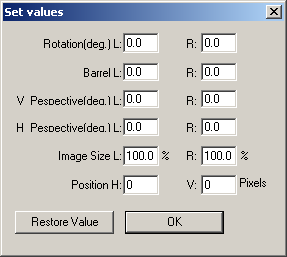
Rather than letting SPM calculate the alignment values, you may enter your own predetermined values.
In the correction process, Autopano,Autopano-SIFT or the internal non-SIFT code will not be required or used.
Manually enter values in the 'Value alignment' dialog-box shown above, or click 'Restore' to load from an individual image's alignment-values file, and then click 'Ok'.
If you now click 'Save' (on the right, under 'Settings Value'), all of those values will be saved, with the rest of the main dialog-box choices, in the MCV file.
In other words, you can apply the alignment values for a particular image to an entire batch of images, time and again.
By default, all images are cropped to eliminate 'blank' space caused by operations such as rotation.
The status of 'Auto Crop after adjustment' here reflects the setting in Preferences.
You may of course disable it for Multi Conversion if you wish.
Any changes made to Angle (image rotation), Size, Position or Gamma may be undone by clicking 'Restore Value' .
This is also required when batch-processing 'Popup Anaglyph' images or the camera views of the Popup Anaglyphs'.
The parameters for correcting the barrel-distortion of zoom lenses at a particular setting, may be determined
using the procedure described here.
You will be prompted to select the text-file containing the saved adjustment parameters.
If Anaglyphs are converted to other formats they are displayed as gray-scale.
Image Editing and Formatting for Digital Projection
All the images may be cropped identically by defining the top-left and bottom-right x,y co-ordinates.
In addition, the images may be resized to a common size, optionally sharpened and swapped left-for-right.
Images intended for display on 3D DLP TV's should be 1280x720 or 1920x1080 depending upon the native resolution of your TV.
You may add user-defined text (such as a copyright notice) by checking the 'Add Text' box.
You may add a custom logo directly on the image or a colored zone by checking the 'Add Logo' box.
The values used for Text and Logo will those set in the last use of the Add Text and Add Logo functions.
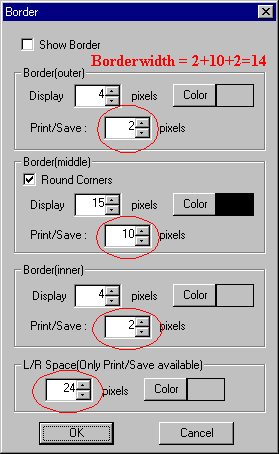 ..
..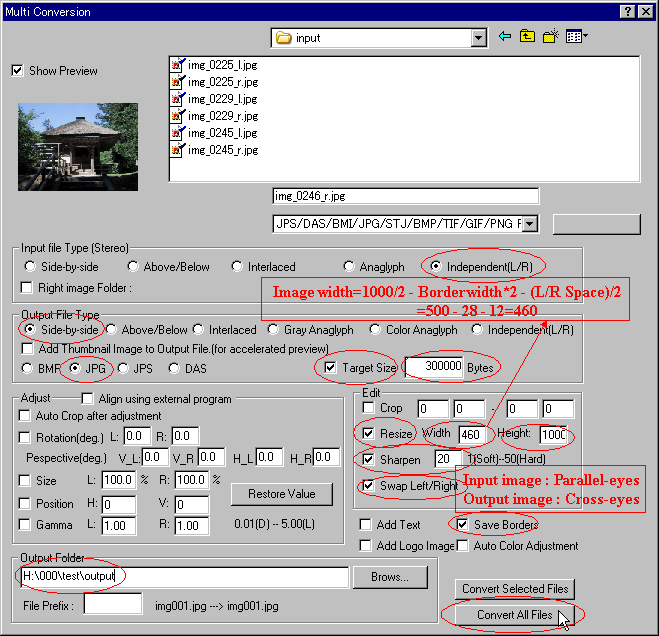
(above screenshot is from a pre-3.11 release of SPM)
Check 'Save Borders' if you want the currently-defined tri-color borders to be added to the Saved images.
If you have specified a Left/Right Space to be added when saving, that will also be saved.
The above example shows how to resize your images so that they meet a target-size, including any tri-color borders or color left/right borders.
The decorative border comprises inner, middle and outer parts that total 14 pixels in width.
To provide separation between the left/right images on the webpages, a border 24 pixels wide and the same color as the webpage background is added when saving.
Consider that the final side-by-side image has to be 1000 pixels wide, meaning the left/right images are 500 pixels wide.
This has to include all borders.
The decorative border is 14 pixels wide each side on each left/rightimage, so we subtract 28 to give 472 pixels width for a single side.
The 24 pixel space between the images is split between them giving 12 pixels per image.
Subtracting that gives an image width of 460 and that is what the image must be resized to.
A similar calculation is done for image-height.
SPM can balance the color/brightness of folders of left/right images.
Choose 'Auto Color Adjustment' . Radio buttons will then be displayed to allow you to select the left or right image as reference.
The reference images are the ones that are assumed to be correctly exposed and are not altered.
To format images for digital projection, after checking the 'Resize' box you will have the option to 'Keep Aspect-ratio'.
(see screenshot at top of page).
On checking that, you will have the option to crop or to apply a border.
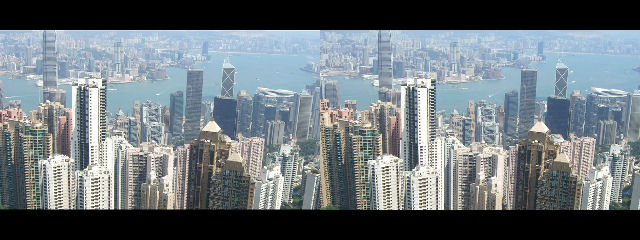
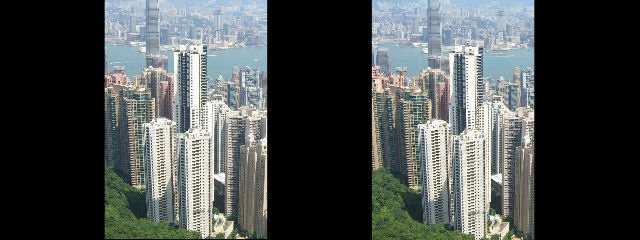
On choosing the latter, your images will be centered in each half of the composite and, if necessary, surrounded by a border in your 'Preferences/View' currently-chosen background color.
Output Folder
Browse to an existing folder or enter the name of a new folder.
If desired, folders may have encryption and/or indexing enabled.
Batch Conversion
Simply select all images in the folder or select individual ones in the usual way (using <Shift> and <Ctrl> as appropriate).
If you choose 'Convert Selected Files', SPM will look for a file with the same name in the 'Right' folder.
If the left-folder file has suffix '_l', it will look for same-name file with suffix '_r'.
If it finds neither, it will simply select the file that is in the same alphabetical order.
In other words, the image that is third in alphabetical order in the left folder will be paired with the image that is third in alphabetical order in the right folder, whatever their individual names.
If you choose 'Convert All Files', the images will simply be processed as pairs in alphabetical order.
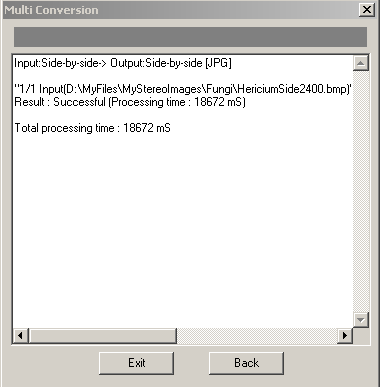
On completion, you will be given the option to Exit or return to MultiConversion.

If you have a dual-core processor and many images to convert, you can check the 'Multi Job'and then 'Convert All Files'.
A second Multiconversion window will open and the task of processing the images will be divided between the two processors.
That is shown above and you can see that each window has its own progress window overlaid.
-
The dialog-box shown above includes typical correction-settings that may be used as a starting-point for correcting batches of LIAC images.
As you can see, there are rotation errors and a slight difference of image sizes.
There is also a vertical-displacement error and the images will need to be cropped.
The crop values obviously depend on the size of your images.
Thanks to Mike Bittner for this information.
![]()



 ..
..



